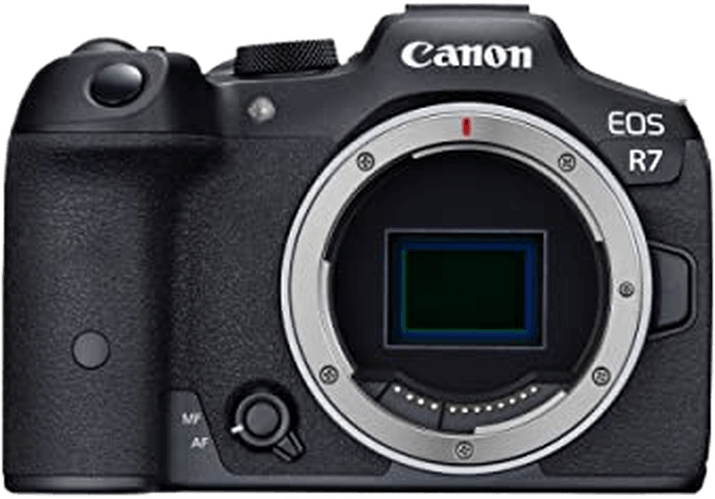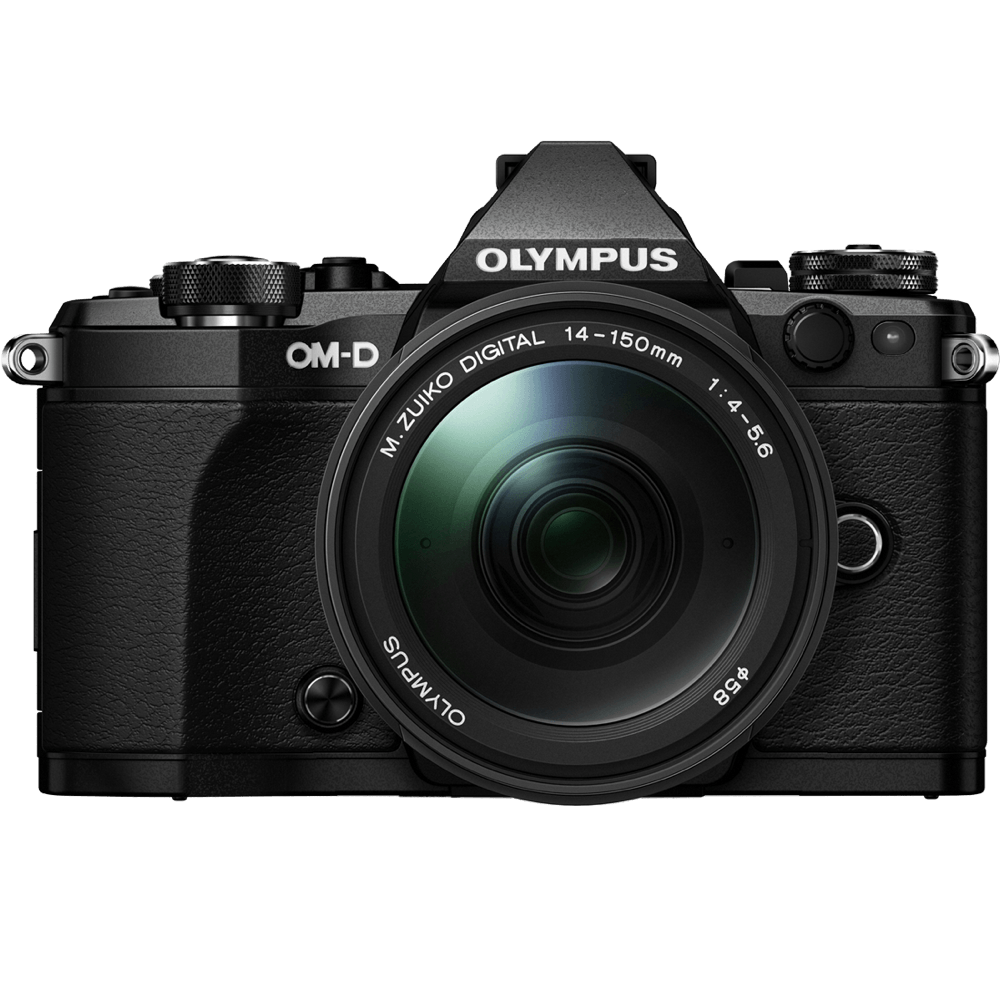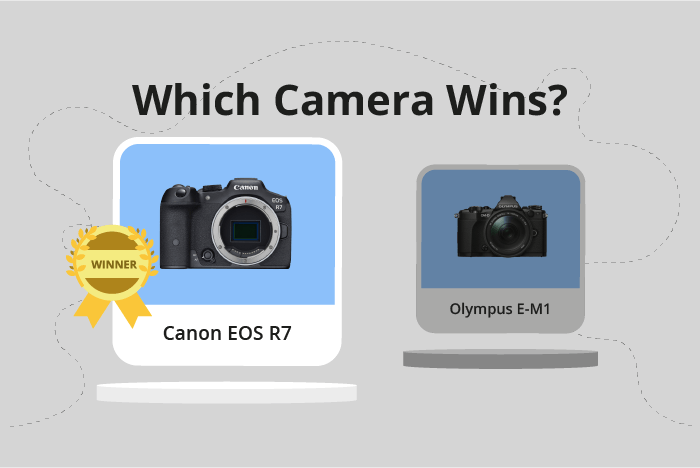Canon EOS R7 vs Olympus OM-D E-M1 Comparison
Canon EOS R7

Olympus OM-D E-M1

The Canon EOS R7 outperforms the Olympus OM-D E-M1 with a score of 83/100 compared to 59/100. Both cameras are mirrorless and were introduced with similar launch prices, $1500 for the EOS R7 and $1399 for the E-M1. They share a compact design, with the EOS R7 measuring 132x90x92mm and the E-M1 at 130x94x63mm.
The EOS R7 excels with its more recent release in 2022, offering updated features and technology. On the other hand, the E-M1, released in 2013, is lighter at 497g compared to the EOS R7’s 612g, making it more portable for on-the-go photography.
Considering the significant score difference and the EOS R7’s updated features, it is the superior choice for a mirrorless camera. However, the E-M1’s lighter weight may appeal to photographers prioritizing portability.
Canon EOS R7 vs Olympus OM-D E-M1 Overview and Optics
The Canon EOS R7 triumphs over the Olympus OM-D E-M1 in optics, scoring 82/100 compared to the Olympus’ 58/100. Both cameras share some specifications, such as having a CMOS sensor, image stabilisation, and a similar processor. However, the Canon EOS R7 outperforms the Olympus OM-D E-M1 in various aspects.
The Canon EOS R7 boasts 33 megapixels, significantly more than the Olympus OM-D E-M1’s 16.3 megapixels. This higher resolution allows for better image quality and detail. The Canon EOS R7 also has a faster shooting speed of 15 compared to the Olympus’ 10, enabling users to capture more frames per second. The Canon EOS R7’s Digic X processor is more advanced than the Olympus’ TruePic VII, contributing to faster processing and better image quality.
Moreover, the Canon EOS R7 has a higher DXOMARK sensor score of 97, compared to the Olympus’ 73, indicating its superior sensor performance. The Canon EOS R7 features a larger APS-C sensor size, which typically results in better image quality and low-light performance than the Olympus’ Micro Four Thirds sensor. Additionally, the Canon EOS R7 uses the Canon RF lens mount, offering a broad range of high-quality lenses.
On the other hand, the Olympus OM-D E-M1 has a 4:3 aspect ratio, which can be advantageous for specific applications like portrait photography. Nonetheless, the Canon EOS R7’s 3:2 aspect ratio is more versatile for various photographic situations.
Taking all factors into account, the Canon EOS R7 outshines the Olympus OM-D E-M1 in optics, offering higher resolution, faster shooting speed, better processor, and superior sensor performance. While the Olympus OM-D E-M1 may have a unique aspect ratio, its overall optical performance falls short compared to the Canon EOS R7.
Canon EOS R7 vs Olympus OM-D E-M1 Video Performance
The Canon EOS R7 outperforms the Olympus OM-D E-M1 in video capabilities, scoring 91/100 compared to the OM-D E-M1’s 57/100. Despite the difference in scores, both cameras share some common specifications, such as built-in time-lapse functionality. However, the EOS R7 proves to be the superior camera in video performance due to several key features.
The EOS R7 has a maximum video resolution of 4K, with dimensions of 3840 x 2160, offering significantly higher quality than the OM-D E-M1’s Full HD resolution of 1920 x 1080. In addition, the EOS R7 supports a maximum video frame rate of 120fps, providing smoother motion and the ability to create slow-motion footage. In contrast, the OM-D E-M1’s maximum frame rate is limited to 30fps.
While the OM-D E-M1 falls short compared to the EOS R7 in terms of video resolution and frame rate, it still offers time-lapse functionality, matching the EOS R7 in this aspect. However, this shared feature does not compensate for the significant difference in video performance between the two cameras.
The Canon EOS R7’s higher video score is a result of its superior video capabilities, including 4K resolution and a 120fps frame rate. These features make it a better choice for videographers who require high-quality footage and flexibility in their shooting options. Meanwhile, the Olympus OM-D E-M1, although offering time-lapse functionality, lacks the advanced video features of the EOS R7, making it less suitable for those prioritizing video performance.
Canon EOS R7 vs Olympus OM-D E-M1 Features and Benefits
The Canon EOS R7 outperforms the Olympus OM-D E-M1 in features, scoring 85 out of 100 points compared to the E-M1’s 70 points. Both cameras share several specifications, including a 3-inch screen size, touchscreen capabilities, flip screen, GPS, and WIFI connectivity.
The Canon EOS R7 has a higher screen resolution of 1,620,000 dots, providing a clearer and sharper display for users. This advantage allows photographers to better review their images and make adjustments as needed. Additionally, the R7 offers Bluetooth connectivity, making it more convenient for users to transfer files and control the camera remotely.
On the other hand, the Olympus OM-D E-M1 lacks Bluetooth connectivity, which may be a disadvantage for some users. However, the E-M1 still offers essential features such as a touchscreen, flip screen, GPS, and WIFI, making it a capable camera for various photography needs.
In comparing the two cameras, the Canon EOS R7’s higher feature score reflects its superior specifications, particularly in screen resolution and Bluetooth connectivity. These advantages make the R7 a more versatile and user-friendly option for photographers. Meanwhile, the Olympus OM-D E-M1 remains a suitable choice for those who prioritize essential features and may not require Bluetooth capabilities.
Ultimately, the Canon EOS R7 offers a better feature set compared to the Olympus OM-D E-M1, making it the more appealing choice for photographers seeking a camera with advanced specifications and convenience.
Canon EOS R7 vs Olympus OM-D E-M1 Storage and Battery
The Canon EOS R7 outperforms the Olympus OM-D E-M1 in storage and battery with a score of 79 points, compared to the Olympus’ 21 points. Both cameras share common specifications, such as accepting SD, SDHC, and SDXC memory cards. However, the Canon EOS R7 has an advantage with its two memory card slots and compatibility with UHS-II cards, while the Olympus OM-D E-M1 has only one slot.
The Canon EOS R7 has a longer battery life, providing 660 shots per charge with its LP-E6NH battery, whereas the Olympus OM-D E-M1 only offers 350 shots with its BLN-1 battery. Moreover, the Canon EOS R7 supports USB charging, which the Olympus OM-D E-M1 lacks.
There are no significant advantages for the Olympus OM-D E-M1 in storage and battery when compared to the Canon EOS R7. The Canon EOS R7 clearly has better storage options and longer battery life, making it the superior choice in this aspect.
Canon EOS R7 vs Olympus OM-D E-M1 – Our Verdict
Are you still undecided about which camera is right for you? Have a look at these popular comparisons that feature the Canon EOS R7 or the Olympus OM-D E-M1:

